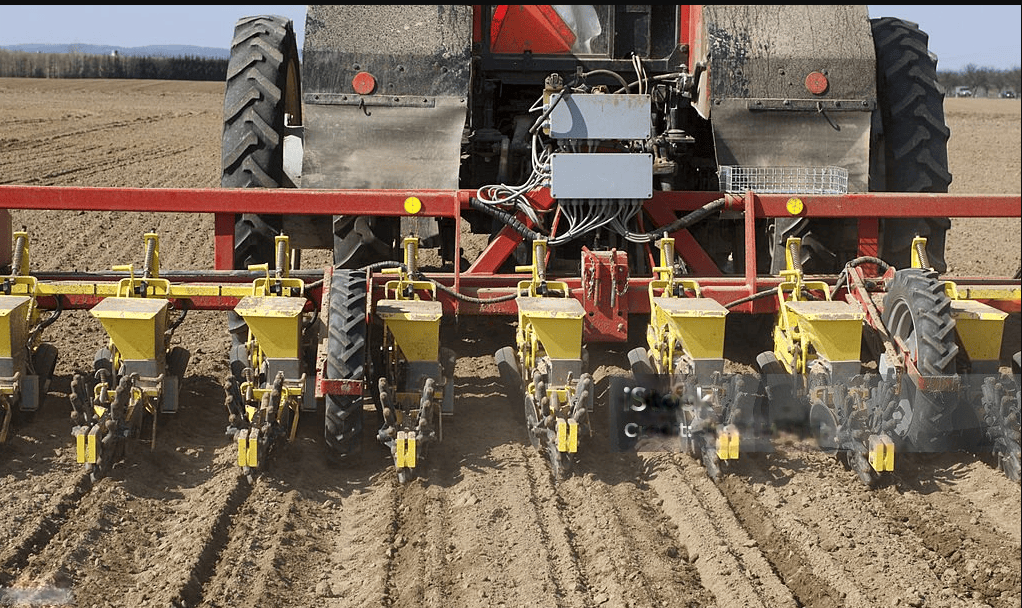Both seed drills and seeders are agricultural implements used for planting seeds, but they differ in their level of precision and the types of seeds they’re best suited for. Here’s the breakdown:
Seed Drill:
-
Precision:
High level of precision. Seed drills plant seeds in rows at a controlled depth and spacing. This ensures even distribution and optimal conditions for germination and growth.
-
Features:
- Uses discs or coulters to create furrows in the soil.
- Has metering mechanisms to measure and distribute seeds accurately.
- Adjustable for different seed sizes and planting depths.
- Suitable for small to medium-sized seeds like cereal grains, vegetables, and forage crops.
-
Benefits:
- Improved seed emergence and yields.
- Reduced seed waste.
- Saves time and labor compared to manual planting.
Seeder:
-
Precision:
Lower level of precision than seed drills. Seeders are used for broader distribution of seeds rather than planting in precise rows. They can scatter seeds over a larger area or drop them into pre-made furrows.
-
Features:
- Less complex than seed drills, often using gravity or airflow to distribute seeds.
- Some seeders allow for some control over seed spacing but are not as precise as seed drills.
- Suitable for larger seeds like beans, corn, and pumpkins.
-
Benefits:
- Faster to use than seed drills for large areas.
- Often simpler and cheaper than seed drills.
- Suitable for specific applications like broadcasting cover crops or overseeding pastures.
Here’s a table summarizing the key differences:
Feature |
Seed Drill |
Seeder |
|---|---|---|
| Precision | High | Low |
| Planting pattern | Rows | Scattered or in furrows |
| Seed depth control | Yes | No or limited |
| Seed spacing control | Yes | No or limited |
| Suitable seed size | Small to medium | Large |
| Benefits | Improved yields, reduced waste, saves time | Faster, simpler, specific applications |
Ultimately, the choice between a seed drill and a seeder depends on your specific needs and the type of seeds you’re planting. If you need high precision and even distribution for smaller seeds, a seed drill is the better option. For larger seeds or broad coverage, a seeder might be more suitable.
I hope this clarifies the differences between seed drills and seeders!

A seed drill is a piece of agricultural equipment that is used to plant seeds at a consistent depth and spacing. It is designed to create furrows in the soil, deposit seeds into these furrows, and then cover them with soil. This precise method of planting ensures that the seeds have optimal conditions for germination and growth. Seed drills are commonly used for planting row crops such as wheat, barley, and maize.
On the other hand, a seeder is a broader term that can refer to both manual and mechanical devices used to distribute seeds over a larger area. Unlike a seed drill, a seeder does not typically create furrows or ensure specific seed depth and spacing. Instead, seeders are often used for broadcasting seeds across fields, pastures, or other open areas. They are especially useful for sowing cover crops, grasses, or legumes in a way that covers a wide area with seeds.
In summary, the key difference between a seed drill and a seeder lies in the precision of seed placement. A seed drill is designed for accurate, controlled planting in rows, while a seeder is used for a more general distribution of seeds over a larger area.
What is the difference between a seed drill and a happy seeder?
A Happy Seeder is actually a type of seed drill, but it has some key differences from a conventional seed drill:
Functionality:
-
Conventional seed drill:
Primarily used for planting seeds in prepared soil after tillage.
-
Happy seeder:
Designed for no-till planting, directly into unworked soil with crop residue remaining from the previous season.
Features:
-
Conventional seed drill:
Mainly consists of furrow openers, seed metering mechanisms, and covering devices.
-
Happy seeder:
Includes additional components like:
- Straw management rotor: Chops and mulches crop residue to prevent clogging and improve seed-to-soil contact.
- Fertilizer applicator: Places fertilizer directly in the sowing row for increased efficiency.
Application:
- Conventional seed drill: Suitable for various soil types and seed sizes, but struggles with heavy residue.
- Happy seeder: Particularly beneficial in areas with stubble burning issues, promoting sustainable agriculture and soil health.
Here’s a table summarizing the key differences:
Feature |
Conventional Seed Drill |
Happy Seeder |
|---|---|---|
| Functionality | Tillage-based planting | No-till planting |
| Straw management | No specific handling | Chopping and mulching residue |
| Fertilization | Separate application | Row-placed application |
| Soil type suitability | Varied | More suitable for residue-laden fields |
| Environmental impact | Potential for soil erosion | Promotes soil health and reduces air pollution |
Choosing between a seed drill and a Happy seeder depends on your specific needs and context:
-
Conventional seed drill:
A versatile option for diverse field conditions and seed sizes.
-
Happy seeder:
Ideal for managing crop residue, reducing tillage, and promoting soil health, especially in regions with stubble-burning concerns.
I hope this helps clarify the differences! Feel free to ask if you have any further questions.

What is a seeder tool?
The term “seeder tool” can refer to a variety of tools used for planting seeds, depending on the context.
Here are some possibilities:
Garden Seeder Tools:
- Handheld seeders: These small, portable tools come in various designs, often with reservoirs for different seeds and mechanisms to distribute them precisely into rows or individual holes. Examples include:
- Sow Perfect Seeder: Creates evenly spaced seed holes in trays or directly in the soil.
- Stand ‘n Plant Seeder: Easy-to-use tool for planting larger seeds like onions and pumpkins.
- Dibber: Creates holes in the soil for individual seed placement.
- Seed trays and mats: These pre-portioned containers and mats offer controlled environments for seed germination and initial growth. They often have designated spots for individual seeds, simplifying planting and spacing.
Agricultural Seeders:
- Seed drills: Precision planting machines used on farms to sow seeds in precise rows at controlled depths and spacing.
- Broadcast seeders: Used for wider distribution of seeds over larger areas, scattering them on the ground or dropping them into pre-made furrows.
Leatherworking Seeder:
- A stamp-like tool used in leather carving to create small circular impressions resembling flower seeds, often adding detail to floral designs.
To help me provide you with a more specific answer, could you tell me more about the context in which you encountered the term “seeder tool”? What are you planning to use it for, or where did you see it mentioned? Knowing more details will help me narrow down the possibilities and give you the most relevant information.




